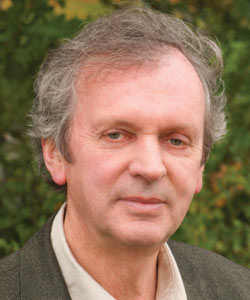Part one in a series of two
Are minds and memories inside brains? Are the laws of nature fixed? Is nature purposeless and are phenomena like telepathy illusory? Not necessarily, says U.K. scientist Rupert Sheldrake in his latest book, The Science Delusion, a title that challenges the paradigms of high-profile materialists such as Richard Dawkins. This article looks at some ideas set out in the book.
Rupert Sheldrake, a former Director of Studies at Cambridge University, is well known for his unorthodox approach to biology. In addition to more conventional research, he has investigated the sense of being stared at and telepathy.
In his latest book, which is titled Science Set Free: 10 Paths to New Discovery in North America, Sheldrake challenges 10 core beliefs that he holds most scientists take for granted, despite a lack of evidence. These include the conservation of matter and energy, that conventional medicine is the only kind that works, that all matter is unconscious, and that humans are merely genetically programmed robots.
The book highlights the rift between paranormal researchers and mainstream scientists.
“The materialist premise is that the nature of minds is already understood in principle: mental activity is brain activity, and is located inside heads,” writes Sheldrake. “Hence psychic phenomena are impossible.”
“The premise of psychic researchers is that psychic phenomena are possible, although not yet understood; and only by studying them can more be found.”
Sheldrake goes into great detail describing how people went from believing the whole universe was alive to thinking that everything, including planets and animals, is mechanical and governed by mathematics.
“The starting point for modern science was the rejection of the older, organic view of the universe. The machine metaphor became central to scientific thinking, with very far-reaching consequences.”
He goes on to accuse materialists of smuggling vitalism into materialism by the back door.
“Mechanists expel purposive vital factors from living animals and plants, but then they reinvent them in molecular guises. One form of molecular vitalism is to treat genes as purposive entities with goals and powers that go far beyond those of a mere chemical like DNA. The genes become molecular entelechies. In his book The Selfish Gene, Richard Dawkins endowed them with life and intelligence.”
DNA Does Not Hold All the Answers
Sheldrake points to the Human Genome Project as the great failure of materialism. He quotes The Selfish Gene: “This DNA can be regarded as a set of instructions for how to make a body ... It is as though, in every room of a gigantic building, there was a bookcase containing the architect’s plans for the entire building. The ‘bookcase’ in a cell is called the nucleus. The architect’s plans run to 46 volumes in humans—the number is different in other species.”
If DNA really is the blueprint for living organisms, understanding it will bring a revolution in the science of life. States and private enterprise have invested billions in biotechnology. The Human Genome Project alone cost US$3 billion. Scientists dreamed of preventing and curing most if not all human diseases. However, after the human genome was fully sequenced in 2003, biologists were left scratching their heads, wondering why humans are so different from other organisms.
Sheldrake points to the “missing heritability problem:” “In practice, the predictive value of human genomes turned out the be small, in some cases less than that achieved with a measuring tape [...] By measuring the height of parents, their children’s heights can be predicted with 80 to 90 percent accuracy [...] Recent ‘genome-wide association studies’ compared the genomes of 30,000 people. In other words, the ’height' genes did not account for 75 to 85 percent of the heritability of height.”
Sheldrake quotes Jonathan Latham, director of the Bioscience Resource Project, “The most likely explanation for why genes for common diseases have not been found is that, with few exceptions, they do not exist. ... The likelihood that further searching might rescue the day appears slim. A much better use of the money would be to ask: If inherited genes are not to blame for our commonest illnesses, can we find out what is?”
As well as costing a lot of money, molecular biology has drastically affected the way biology is taught, he says. Scientists have now dropped the taboo over epigenetics, the theory that acquired characteristics can be passed to offspring. (Sheldrake gives the example of a body builder’s children tending to have larger muscles). But scientists are still unwilling to challenge the assumption that heredity is passed down materially, through molecules and chemicals.
Morphic Resonance and Morphogenetic Fields
As an answer to the problems of materialistic biology, Sheldrake offers his own theory: morphic resonance and morphogenetic fields. A morphogenetic field is a concept from developmental biology; it refers to mathematical structures that govern the development of different cell structures in the embryo.
The materialistic understanding is that chemical genes and proteins interact with mathematics to create the embryo. Inheritance is carried within the chemicals.
Sheldrake offers another explanation; morphogenetic fields inherit their form via morphic resonance from previous similar organisms. Such resonance takes place across time and space.
“Inheritance depends on genes and on morphic resonance,” he writes. “If fruit flies develop abnormally under abnormal conditions, then the more the abnormality occurs, the more likely it will be to happen again under the same conditions.”
Sheldrake compares geneticists to people who think a TV’s image and sound are produced by the wires and transistors inside the set. The geneticist does not believe in electromagnetic waves and hopes to understand how the TV works by evermore detailed analysis of the components and how they interact.
Although genetic mutations can cause changes in an animal’s body or behavior, this does not prove that body and behavior are programmed in the genes.
“Some genetic mutations affect the tuning, with the result that a part of the embryo resonates with one morphogenetic field rather than another, resulting in a different structure, like a TV set tuned to a different channel.”
He gives examples of this, such as fruit flies developing legs in the place of antenna. The theory of morphic resonance explains why homeobox genes (genes that control the development of embryos and larvae) in species as different as humans and fruit flies are so similar; the real blueprints for development are contained in morphogenetic fields.
Sheldrake holds that this theory is testable and has set out evidence in previous books. He also holds that a virtual future organism may influence the development of an embryo backward through time. He calls such a virtual end an “attractor.”
Morphogenetic fields, in his view, are but one type of morphic field, which govern everything from animal and human behavior as well social and cultural systems to crystals and planetary systems.
It is very difficult to obtain a new type of crystal, but after it has been made repeatedly, all over the world, chemists will find it easier to make.
What Are Memories?
People usually think that memories are stored as traces in the brain. Sheldrake disputes this and offers a radically different explanation.
Many studies have sought to identify the location of physical memory traces in the brain but have failed. Experiments often involved teaching animals a skill, incising or cutting out brain parts, and then testing to see if they still remember the skills.
All have failed to pin down the location of memory and only proved that memories can be retained by creatures like monkeys, squirrels, and octopuses even after large chunks of brain are removed, leading researchers to conclude that memories are stored in the whole brain.
Sheldrake talks of humans with extreme hydrocephalus (water on the brain). Some are left seriously retarded by the condition, with much of the skull filled with cerebrospinal fluid. Others, however, have IQs way above 100. In one case, a young man who had a brain only 5 percent of normal size got a first class degree in mathematics. Sheldrake cites a study on caterpillars which concluded that moths could remember what they had learned as caterpillars.
Again, resorting to the TV analogy, Sheldrake proposes that when remembering, we may be tuning into ourselves in the past via morphic resonance.
Sheldrake also claims that thanks to morphic resonance, if one type of animal learns a new trick, it is easier for similar animals to learn the same trick later.
“If animals, like squirrels, learn a new trick in one place, the more squirrels that learn it, the easier it should become for squirrels of the same species all over the world.”
This theory is testable and Sheldrake cites a study testing rats’ ability to escape from a water maze. Experiments conducted at Harvard, Edinburgh, and Melbourne universities showed that all similar rats learned how to escape faster after some had learned to escape previously. They found that this effect was not passed down through genes.
Such an effect could also exist for humans learning to snowboard or play computer games but is hard to measure.
One human skill that is easy to measure is IQ test performance. Here, Sheldrake offers his own explanation for the Flynn Effect, the steady improvement of IQ test scores over time, measured in many parts of the world.
People are not becoming more intelligent, but rather, the tests are becoming easier to do because so many people have done them before. Universities in America and Europe have tested morphic resonance in human learning, and most studies, says Sheldrake, have given “positive, statistically significant results.”
Telepathy and Psychic Phenomena
Many studies on telepathy have been carried out in labs, often involving one person guessing which card or picture someone else is holding. Although the success rate was usually only a little above that expected by random guessing, put together, the overall results were “hugely significant statistically,” says Sheldrake.
He disagrees with skeptics’ claims that this is due to researchers only publishing positive results. To bring the numbers back down to the random guessing rate, there would have to be more than 3,300 unpublished studies for every conclusive one.
Sheldrake goes on to point out two major flaws in lab testing: tests involve strangers trying to read each others’ minds in a controlled, repetitive, and boring environment. Telepathy, says Sheldrake, usually occurs between people who are closely bonded.
Nonetheless, a series of studies in the 1970s involving sensory deprivation and four different pictures achieved hit rates of 35 per cent and 34 per cent, well above the 25 percent result of guessing at random. When studies were conducted with people who knew each other well, the results were even higher.
Another study found that it was possible to influence people’s dreams. Sheldrake gives an example: “The subject dreamed of a dead rat in a cigar box, while the sender was looking at a picture of a dead gangster in a coffin.”
Sheldrake says that “in most, if not all, traditional societies, telepathy seems to be taken for granted and put to practical use.” In Norway, there is a special word—vardøger—that describes knowing someone is going to visit.
Sheldrake refers to an account by the Afrikaner adventurer Laurens van der Post, describing how the Kalahari bushmen he was living with knew when members of the tribe had killed an eland 50 miles away from their camp. Sheldrake encourages anthropologists to study this phenomenon.
Sheldrake designed his own experiment to test for telephone telepathy. He monitored someone in a room for a period of time during which one of four of the person’s close friends were to call. Sheldrake selected a friend at random and asked them to call. The person in the room had to guess who was on the line before picking up.
This experiment was designed to eliminate the possibility of the person guessing from friends’ routines and unconsciously predicting when they were most likely to phone. In 45 percent of cases, the person guessed correctly, way above the 25 percent chance level. Sheldrake also found that with people who didn’t know each other, this experiment yielded results around the chance level.
Distance didn’t seem to matter and this experiment worked even with friends thousands of miles away from each other.
Telepathy doesn’t only occur among humans, but also among animals as well as between humans and animals. Sheldrake has carried out experiments that have confirmed that dogs and cats know when their owners are returning.
Read part two here
The Epoch Times publishes in 35 countries and in 19 languages. Subscribe to our e-newsletter.







